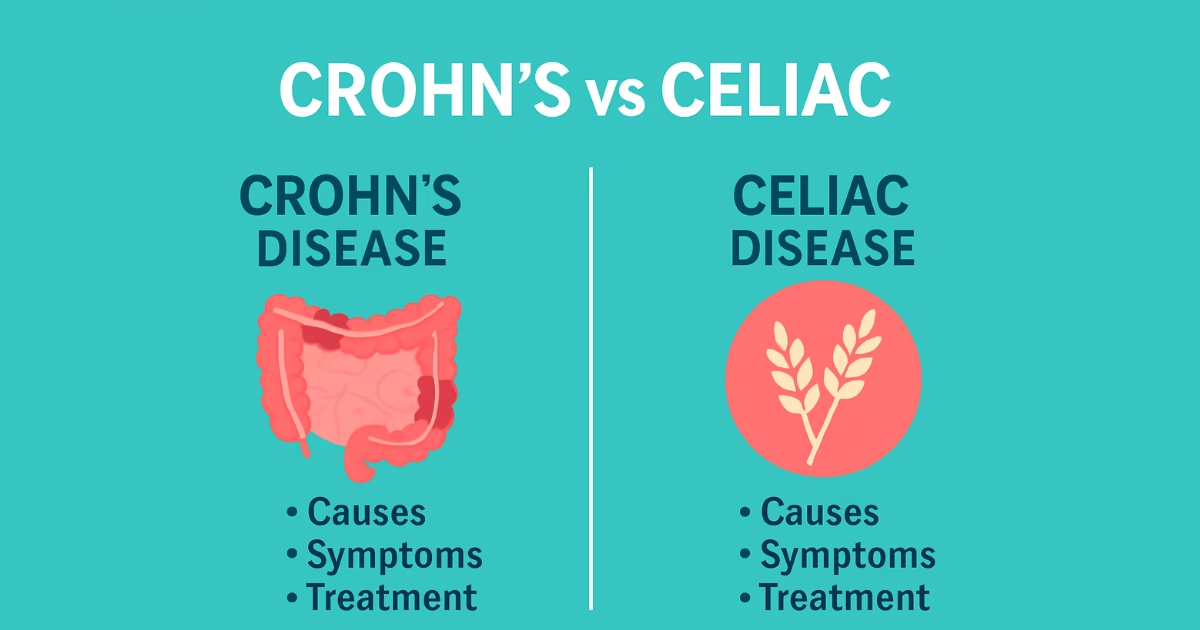Introduction: Understanding Crohn’s vs Celiac
When it comes to chronic digestive diseases, Crohn’s vs Celiac are two conditions that are often confused due to their similar symptoms, but they are fundamentally different in nature. Both impact the gastrointestinal system, yet their causes, triggers, and treatments vary significantly. Crohn’s disease is a type of inflammatory bowel disease (IBD), whereas Celiac disease is an autoimmune disorder triggered by the ingestion of gluten. While both conditions can lead to significant health challenges, understanding the differences between them is crucial for proper diagnosis and treatment. In this article, we’ll dive deep into the causes, symptoms, treatment options, and long-term impact of each condition to help you better understand Crohn’s vs Celiac and how they affect those living with them.
What Are Crohn’s and Celiac?
When comparing Crohn’s vs Celiac, it’s essential to first understand the nature of each condition. Both diseases affect the digestive system, but their origins and how they impact the body differ significantly.
Crohn’s Disease is a chronic inflammatory condition that can affect any part of the gastrointestinal tract, from the mouth to the anus. It is part of a group of disorders known as inflammatory bowel diseases (IBD), and it causes inflammation, ulcers, and in some cases, strictures or blockages. The exact cause of Crohn’s is unknown, but it is believed to involve a combination of genetic predisposition and an abnormal immune system response, where the body mistakenly attacks its own tissues.
On the other hand, Celiac Disease is an autoimmune disorder that primarily affects the small intestine. When individuals with Celiac disease consume gluten (a protein found in wheat, barley, and rye), their immune system reacts by damaging the lining of the small intestine. This damage impairs the absorption of essential nutrients, leading to malnutrition and a host of other potential complications. Celiac disease is genetically inherited, with certain genes (HLA-DQ2 and HLA-DQ8) making individuals more susceptible to developing the condition when exposed to gluten.
While both conditions are autoimmune-related, they have distinct causes and affect the body in different ways, making their diagnosis and treatment approaches quite unique.
Causes of Crohn’s and Celiac
When comparing Crohn’s vs Celiac, it’s crucial to understand what triggers these two diseases, as their causes are quite different.
Crohn’s Disease Causes
The precise cause of Crohn’s disease remains unknown, but several factors play a role in its development. Genetics are believed to be a key factor, as individuals with a family history of Crohn’s are more likely to develop the disease. An abnormal immune system response is another contributing factor. In people with Crohn’s, the immune system mistakenly targets the gastrointestinal tract, causing chronic inflammation. Environmental factors such as diet, smoking, and possibly infections might also trigger or exacerbate the condition.
Celiac Disease Causes
Unlike Crohn’s, Celiac disease has a clear genetic component. It is an autoimmune disorder triggered by the consumption of gluten in individuals who are genetically predisposed. The two main genes involved in Celiac disease are HLA-DQ2 and HLA-DQ8, and individuals carrying these genes are more likely to develop the condition when exposed to gluten. The immune system of someone with Celiac disease attacks the lining of the small intestine, causing damage. Environmental triggers like viral infections and changes in diet may also play a role, though gluten remains the primary cause.
Although both conditions have genetic predispositions, the way they manifest in the body and the substances that trigger them differ.
Key Differences Between Crohn’s and Celiac
There are several key differences between Crohn’s and Celiac that set them apart, both in terms of their effects on the body and how they are managed.
Affected Areas:
Crohn’s disease can affect any part of the gastrointestinal (GI) tract, including the mouth, stomach, intestines, and anus. It often affects the lower part of the small intestine and the colon. Celiac disease, on the other hand, specifically impacts the small intestine, particularly the villi (tiny hair-like structures) that are essential for nutrient absorption.
Immune System Response:
In Crohn’s disease, the immune system incorrectly targets the digestive tract, causing inflammation and ulcers. In contrast, Celiac disease is an autoimmune response triggered by gluten, which leads to damage of the intestinal lining and malabsorption of nutrients.
Symptoms and Flare-Ups:
While both conditions involve digestive issues, the symptoms differ. Crohn’s disease tends to cause chronic diarrhea, abdominal pain, cramping, and weight loss, with flare-ups that can last for weeks or months. Celiac disease primarily leads to digestive symptoms like bloating, diarrhea, and fatigue, but over time, untreated Celiac can lead to other systemic issues like osteoporosis and infertility.
Symptoms of Crohn’s vs Celiac
Crohn’s Disease Symptoms
People with Crohn’s disease experience a range of symptoms, and these can vary from person to person. Common signs include:
- Abdominal pain and cramping
- Diarrhea, sometimes with blood or mucus
- Fatigue and general malaise
- Weight loss, which may be significant in severe cases
- Fever and nausea during flare-ups
- In some cases, skin problems, joint pain, and eye inflammation may also occur.
Over time, complications such as intestinal blockages, fistulas, and nutritional deficiencies can arise, which can worsen the symptoms.
Celiac Disease Symptoms
The symptoms of Celiac disease are quite diverse and can affect not only the digestive system but also other parts of the body. Common symptoms include:
- Bloating and discomfort after eating gluten-containing foods
- Chronic diarrhea or constipation
- Fatigue and weakness
- Anemia, resulting from iron deficiency
- Weight loss or stunted growth in children
- Skin rashes (dermatitis herpetiformis) that are itchy and blistering
- Joint pain and bone fractures due to malabsorption of calcium and other nutrients
Unlike Crohn’s disease, Celiac disease can sometimes be silent, with few noticeable digestive symptoms. Some individuals experience more systemic effects, such as neurological symptoms or infertility, making it harder to diagnose without proper testing.
Diagnosing Crohn’s vs Celiac
Diagnosing Crohn’s vs Celiac requires different approaches, as the tests and procedures used for each condition are specific to their underlying causes.
Crohn’s Disease Diagnosis
Diagnosing Crohn’s disease often involves a combination of tests, including:
- Blood tests to check for anemia and signs of inflammation
- Colonoscopy or endoscopy to visually inspect the GI tract and take biopsies
- Imaging tests such as CT scans or MRIs to identify inflammation and complications like strictures or fistulas
- Stool tests to rule out infections that might mimic Crohn’s symptoms
Because the symptoms of Crohn’s disease can overlap with other conditions like irritable bowel syndrome (IBS) or infections, a thorough examination is necessary.
Celiac Disease Diagnosis
The diagnosis of Celiac disease usually involves the following steps:
- Blood tests to check for elevated levels of specific antibodies, such as anti-tTG (tissue transglutaminase)
- Genetic testing to determine the presence of the HLA-DQ2 and HLA-DQ8 genes
- Endoscopy with a biopsy of the small intestine to check for damage to the villi, the hallmark of Celiac disease
It’s essential for patients to be consuming gluten before undergoing testing, as stopping gluten before diagnosis can affect the accuracy of the results.
Treatment Options: Crohn’s vs Celiac
The treatment approaches for Crohn’s vs Celiac differ significantly due to the nature of each condition.
Treatment for Crohn’s Disease
Currently, there is no cure for Crohn’s disease, but treatment can help manage the symptoms and prevent flare-ups. Treatment options include:
- Medications, such as anti-inflammatory drugs, corticosteroids, immunosuppressive drugs, and biologics to reduce inflammation and manage immune response
- Surgery in severe cases, including the removal of affected parts of the intestine
- Dietary changes, with some patients finding relief by avoiding certain foods that trigger symptoms
Managing Crohn’s disease often involves a combination of lifestyle adjustments, medications, and regular monitoring by a healthcare professional.
Treatment for Celiac Disease
For Celiac disease, the only effective treatment is a lifelong gluten-free diet. This eliminates all sources of gluten from the diet, allowing the small intestine to heal and preventing further damage. In some cases, doctors may recommend:
- Nutritional supplements to address deficiencies in vitamins and minerals (such as iron, calcium, and vitamin D)
- Monitoring for other autoimmune conditions and complications, such as osteoporosis
Unlike Crohn’s, which requires ongoing medication and sometimes surgery, Celiac disease can be managed by simply avoiding gluten-containing foods.
Long-Term Impact and Complications
Crohn’s Disease Complications
Chronic Crohn’s disease can lead to long-term complications, including:
- Intestinal blockages, which may require surgery
- Fistulas (abnormal connections between organs or tissues)
- Nutritional deficiencies due to impaired nutrient absorption
- Increased risk of colon cancer in individuals with long-standing disease
With proper management, many of these complications can be prevented or minimized.
Celiac Disease Complications
If Celiac disease is left untreated, it can lead to serious complications such as:
- Osteoporosis due to poor calcium absorption
- Infertility or miscarriage in women
- Increased cancer risk, especially intestinal cancers or lymphoma
- Neurological issues, such as neuropathy and seizures
However, a strict gluten-free diet often prevents these complications and promotes healing.
Crohn’s vs Celiac: How to Manage Your Condition
Whether managing Crohn’s disease or Celiac disease, adopting a proactive approach to treatment is essential. Here are some tips:
- For Crohn’s disease: It’s important to work with a healthcare team to find the right combination of medications and lifestyle adjustments. Regular checkups and avoiding triggers like smoking or stress can help prevent flare-ups.
- For Celiac disease: Following a gluten-free diet strictly is key. Patients should educate themselves about hidden sources of gluten, read labels carefully, and be cautious about cross-contamination.
Both conditions benefit from support groups, counseling, and resources that help individuals connect with others who share similar experiences.
Conclusion: Understanding the Differences and Similarities
While both Crohn’s vs Celiac are chronic, autoimmune-related conditions affecting the digestive system, they differ significantly in their causes, symptoms, and treatments. Crohn’s disease involves inflammation of the GI tract and requires ongoing medical management, while Celiac disease is triggered by gluten and can be managed with a gluten-free diet. By understanding the key differences and similarities, individuals can better navigate diagnosis and treatment, leading to improved quality of life. If you suspect you have symptoms of either condition, it’s important to seek medical advice to receive an accurate diagnosis and begin appropriate treatment.

Hi, I’m Shafy Ali – a curious mind and passionate writer at Celiac Magazine. I cover a little bit of everything, from everyday tips and how-tos to deeper dives into topics that spark conversation. I enjoy turning research into readable, relatable content that informs and inspires. Whatever the subject, I aim to keep it clear, engaging, and genuinely useful.

